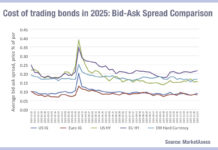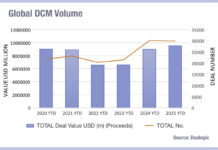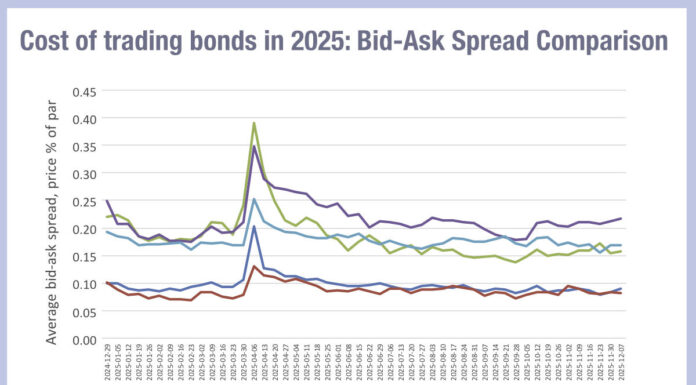The adoption of credit futures as a mainstream credit trading vehicle is broadening across venues and currencies: US$ iBoxx total return based futures traded on Cboe Global Markets have seen the greatest US dollar credit futures volumes, with open interest (OI) reaching US$1.8 billion, while EUR Bloomberg-linked contracts are anchored at Eurex with OI of €2.2 billion. ICE having started early with CDS futures that never gained traction is honing its offering, while CME is playing catchup with a suite of product including duration hedged futures.
Credit futures have moved decisively into the mainstream as desks adopt the ease of access and economics of central limit order book (CLOB) futures to gain exposure to liquid corporate bond indices for hedging and investment purposes. The current listed suite splits into two construction styles: total-return contracts, which track the full index performance including carry, and duration-hedged variants designed to isolate credit spread while neutralising most rate beta. The underliers to the futures are the common benchmarks that anchor institutional portfolios and ETFs: S&P DJI iBoxx iShares for the Cboe contracts (with the related ETFs HYG and LQD being the most traded credit products worldwide), and Bloomberg US and Euro corporate indices for CME and Eurex, respectively. ICE four launched but not yet trading futures are based on MSCI / MarketAxess indexes.
The take-up in dollar markets has been particularly clear over the past 18 months. Aggregating Cboe and CME US$ contracts, average daily notional rose 600% in that period from near US$56 million in January 2024 to US$398 million in August 2025, while open interest expanded more than ten times from US$190 million to just over US$2 billion. OI has grown faster than flow, pointing to persistent positioning and repeat hedging rather than just market maker volumes led by exchanges’ trading incentives.
David Litchfield, director at Cboe Global Markets and credit derivatives specialist, told The Desk:” Volume alone doesn’t always tell the full story when it comes to liquidity – whether high or low. How a market reacts in times of stress or how the order book behaves when an order is worked can be more telling.”
Cboe’s iBoxx suite is where most US$ credit futures take place. IBIG, the S&P DJI iBoxx iShares US$ investment grade (IG) total-return future, printed US$143 million of ADV in August with US$867 million of open interest. IBHY, its iBoxx US$ high yield (HY) twin, added US$107 million of ADV with US$821 million of OI. Combined, Cboe’s US$ pair accounted for approximately US$250 million of daily notional and US$1.69 billion of OI in the month. What is particularly remarkable is that both volume and OI did not dip in April and May 2025, when volumes and OI retreated at both Eurex and CME. As some market participants told us, market makers preferred safety in volatile times over chasing trading incentives.
Litchfield said, “Given the direct link to HYG and LQD, liquidity providers in Cboe’s credit futures are almost agnostic if, say, $100m of HY risk is priced up in ETF, TRS or futures wrapper – it’s just $100m of HY risk. Those block trades and the increase in open interest show more widespread buy-side usage.”
CME provides breadth within the US$ complex by offering both total-return and duration-hedged exposures. IQB, the Bloomberg US corporate Investment grade total-return contract, traded around US$98 million ADV in August with US$193 million of OI.
HYB, the Bloomberg US corporate high yield very liquid total-return line had US$23 million ADV and US$107 million OI in August. Alongside those, the duration-hedged twins—DHB for IG and DHY for HY— designed to access more targeted spread exposure, had US$15 million and US$12 million of ADV, respectively, and US$75 million and US$27 million of OI, respectively in August 2025.
Europe burst into credit futures trading in June 2024, where credit-specific vehicles like the LQD and HYD ETF equivalents are less prevalent than in the US.
Lee Bartholomew, co-global head of derivatives products & markets at Eurex, said: Our contracts are actively utilised by real money investors who typically maintain substantial open interest positions for strategic allocation and long-term hedging purposes. Alongside them, we see participation from tactical traders, investors – both on the real money and fast money sides – who operate with shorter holding periods, generally around a week.
Euro-denominated Bloomberg-linked contracts have built a substantial base of open interest from their launch in June 2024, with total Euro OI reaching about €2.26 billion in July 2025, having started with high interest and an OI of €1.75 billion. Within that, FECX, the Bloomberg Barclays MSCI Euro IG total-return future, carried the larger share, while FEHY, the Bloomberg Euro HY line, rounded out the Euro complex. ADV in EUR spiked around launch months and then normalised; even so, the steady climb in open interest indicates regular use for buy-and-hold hedges and benchmark overlays among European credit investors.
“Our products attract significant activity from cash bond traders and ETF market makers,” said Bartholomew. “These participants engage in frequent position adjustments driven by hedging needs and proprietary strategies linked to movements in adjacent markets. Their holding periods are notably short, often intraday and in some cases measured in seconds”
Eurex also lists US$-linked Bloomberg contracts, which contributed meaningfully to monthly activity, and a GBP line referencing the Bloomberg GBP liquid corporate index, where open interest remains small but persistent.
©Markets Media Europe 2025












